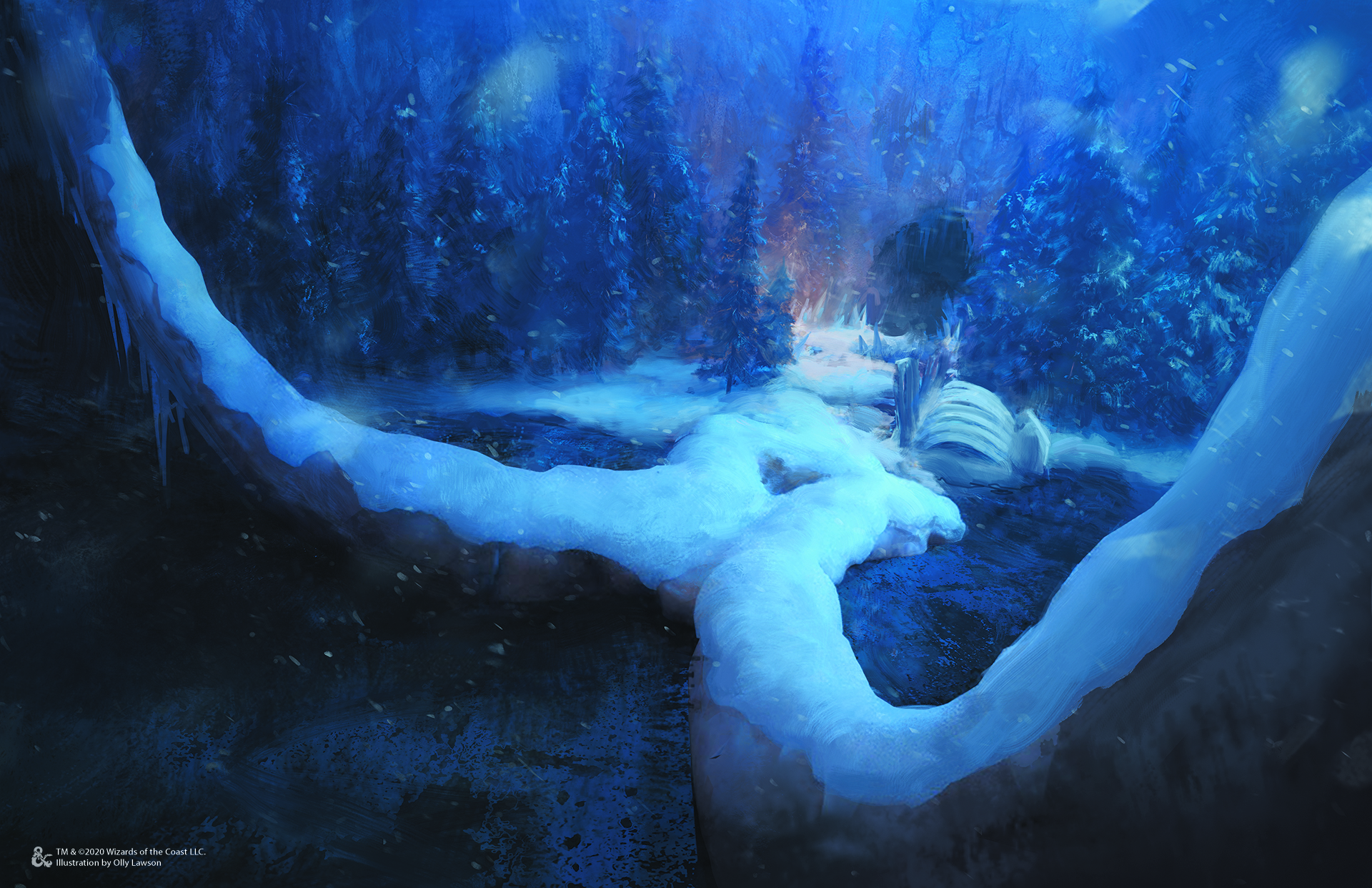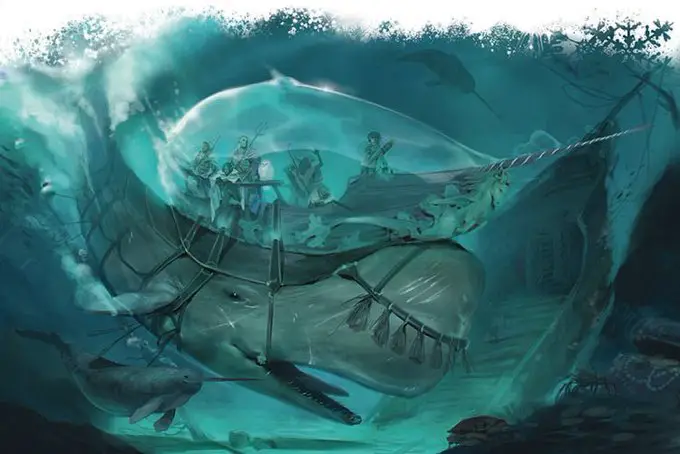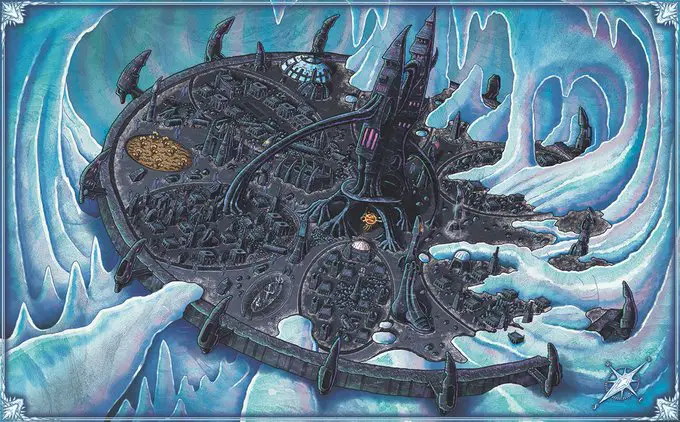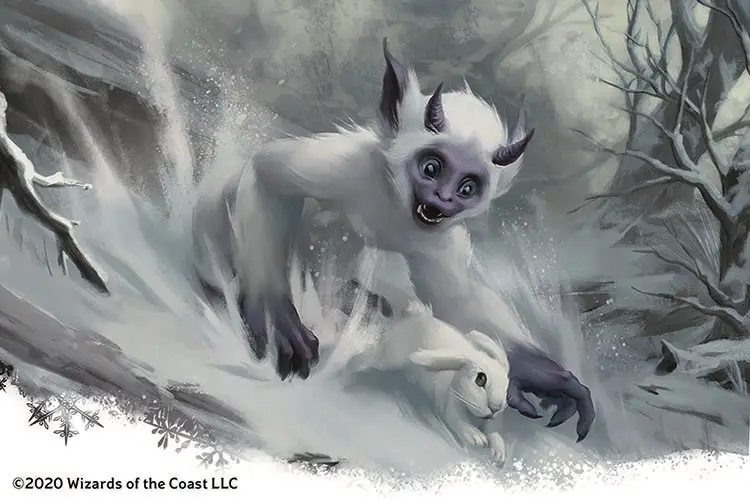There are few places in D&D with more fame than Icewind Dale. Thanks to the classic trilogy of that name by RA Salvatore, and the subsequent fame of one Drizzt Do’Urden (now having starred in 36 novels since 1988), the frozen north of Faerûn has become one of the most popular locations ever created in the history of the game. So when the announcement came down that the newest adventure was going to be set there, people were excited. But rather than the epic high fantasy that found in the popular novels, we got something different. Something very, very different. Something as dark and strange and beautiful as a winter night. What we got…was Rime of the Frostmaiden.
Warning: Review Contains Spoilers for Icewind Dale: Rime of the Frostmaiden
Land Of The Ice And Snow

The Icewind Dale that many people remember is long gone. It’s been over a century since the time of Drizzt, Wulfgar, and Cattie-brie, and the stalwart people of Ten Towns now suffer in the grasp of an eternal winter. The snow has piled up, the waters have frozen over, and the dark wilderness of Icewind Dale encroaches more and more every day. This is the Icewind Dale that players will enter for this adventure. One of the things that head writer Chris Perkins wanted to emphasize in this adventure is a sense of isolation and hopelessness, and by Garl they’ve done it. Unlike the bustling metropolises of Baldur’s Gate and Waterdeep, the starting points for the previous two adventure releases, the communities that make up Ten Towns are suffering. This is the setting for the first chunk of the adventure, and it does a great job of establishing the very different setting that players are entering.
Each of the towns has its own characters, secrets, and problems that players can choose to help solve. One of the most helpful things in the book is the little infographic each town gets showing how friendly and comfortable they are, as well as how many services they offer. These also cover their military strength and political situation, which come into play multiple times during the adventure.
The rest of Icewind Dale is even more bleak, and the second part of the adventure sends the party out into the frozen wilds to follow up on story threads set up in town. The players will be dealing with dead gods, violent beasts, and even menaces from space all while they try to fight off the unrelenting cold that makes just the act of travelling a few miles a dangerous journey. I’m not a massive fan of D&D’s wilderness travel rules, and if you implement them to the letter here you’re still going to get bogged down with pointless rolling and waiting. But used sparingly, the blizzards and ice can go a long way towards helping players really feel what their characters are. Positive encounters become godsends, and negative ones become urgent fights for survival.
These first two chunks of the adventure are probably the most memorable portions of the adventure, and the part where the writers really flex their creativity. The quests in Ten Towns and the encounters in Icewind Dale both have an amazing mix of the terrifying (insane cultists, frozen tombs, a killer moose) and the strange (a UFO crash, fake goblins, a killer moose) that really exemplify just how much can be done with D&D. The players also get a lot of power to shape the story as they see fit, so a good DM will need to be willing to communicate and collaborate with players to make sure this part of the adventure works as intended.
Fighting The Frostmaiden

Once you get out of the more exploratory phase of the adventure, things get a bit more linear as it gets into traditional dungeon crawls. They aren’t boring by any means, and there’s still some meaningful decisions to be made, it’s just a much more straightforward experience. The atmosphere continues to shine, as does the very well executed environmental storytelling used throughout Rime. The “final boss” of each of these doesn’t have a set location for the final “showdown,” and the results of earlier quests continue to bleed into the storytelling. Ten Towns is not forgotten however, and there’s a fantastic sequence of events in the story that rewards (or punishes) players for developing connections to the different communities.
The overarching villain of the tale is the Frostmaiden herself, Auril. An evil deity of cold and the winter, Auril is very much the Big Bad of the adventure. All of the bad stuff occurring in Icewind Dale derives from her, and without intervention she will choke the whole region out with her smothering frost. Her presence is palpable from the start, as the Ten Towns whisper of her magic and make sacrifices in order to appease her (even going so far as to sacrifice humans to the cold). The blizzards and ice and monsters that assail the party all are reminders of Auril’s long reach, and these dangers get stronger the closer the adventure gets to her domain.The parts that deal with her and her powers are all the most cohesive parts of the adventure, and the most compelling from a story perspective. The parts that drift away from her are a little weaker, and the pacing of the adventure can be a little inconsistent in places. Auril as a final boss is very neat, as the dungeon leading up to her is a showcase in otherworldly evil and the fight with her should prove to be a complicated puzzle for players to unravel.
Strange Magic

Defeating the “Big Bad” should, logically, be the end of the adventure…but it isn’t. Because underneath the running narrative surrounding Auril, there’s a story of a lost civilization hidden deep under the snows of Icewind Dale. Getting to this civilization, or at least one of its cities, it ultimately the purpose of defeating Auril. You beat her to get a key. There’s ways to get around that, as there are ways to get around many things in this adventure, but it cheapens the all-powerful deity a bit when she’s just guarding a MacGuffin. Plus, the entire final section of the adventure feels like a post-script, a big final dungeon inserted because for whatever reason the writers felt it needed one? Admittedly, this section does fit into the broader context of the Forgotten Realms in a way that the Auril storyline doesn’t, and it does build on some of the mysteries set up in previous adventures. However, the emotional investment just isn’t there.
It’s not a bad dungeon, and in fact this is where the weirdness knob, already cranked a little higher than normal, cranks up real high as the lonely horror of the rest of the book gives way for Lovecraftian madness. Brains in jars dancing with holograms, sentient demiplanes, and demonic librarians are just the tip of the bizarre iceberg at the end of this book. There are some really neat magic items, too, with special mention going to the scroll of Tarrasque summoning, which may be the greatest schmuck-bait I’ve ever seen in D&D.
Like many of the other adventures released in 5e, there are multiple endings to Rime of the Frostmaiden. Which one you get doesn’t really come down to a single player choice (and the one that does is telegraphed from a mile away), but instead is affected by the sum total of the choices the party has made. A DM will need to be familiar with the whole adventure from the get go, and take copious notes, in order to ensure the players end up where they mean to.

Even with the pacing issues, Rime of the Frostmaiden is an extremely strong adventure that avoids some of mistakes previous releases have made, especially in the early part of the adventure when there’s often copious padding. From start to finish, the party feels consequential. The many choices that can be made are carefully constructed and have very satisfying payoffs both good and bad. The setting is what truly shines in Rime, and it creates a fantastic sandbox for DM’s (and DM’s Guild creators) to play in when creating original adventures.
Icewind Dale is a scary place, but not in the way that, say, Barovia is scary. The fear that Icewind Dale causes is visceral and realistic; it’s lonely, and it’s dark. None of the other 5e adventures really get close, as most of them retain the swashbuckling adventure feeling to balance things out. Here, the only things complementing the horror are the truly bizarre, the uncanny, the alien. So it’s obviously not an adventure for everyone, and it’s certainly one that will need discussion before you dive in. But it’s worth it, because there’s so many cool things going on in Rime that have to be seen to believed.
Stray Thoughts
- The art in Rime of the Frost Maiden is as good as ever, capturing the darkness and beauty of the setting perfectly.
- There are humorous things in the story, like a singing Knucklehead Trout mounted on the wall of the local tavern.
- The “character secrets” mechanic is fun and can have some interesting effects on the story, but it’s not super impactful beyond giving characters some extra flavor.
- Considering how many elements of the setting draw on Inuit or Sami culture and mythology, it would have been nice to see writers or consultants with that background work on the project in some capacity.
- The adventure isn’t super complicated to run, and it actively encouraged multiple playthroughs.
- One of the endings is extremely weird and puts players in a very, very difficult position going forward. I’m kind of shocked they even put it in.
Icewind Dale: Rime of the Frostmaiden officially goes on sale on September 15, with a retail price of $49.95. You can pick it up from Barnes & Noble, Amazon, or digitally through D&D Beyond or Fantasy Grounds. You can also pick it up at your local game store, which is your best bet if you can swing it. Not only does it support your local business, brick and mortar stores are the only places selling the gorgeous alternate cover by Hyrdo74 showing the Icemaiden in all her glory.
Have strong thoughts about this piece you need to share? Or maybe there’s something else on your mind you’re wanting to talk about with fellow Fandomentals? Head on over to our Community server to join in the conversation!
Images via Wizards of the Coast

